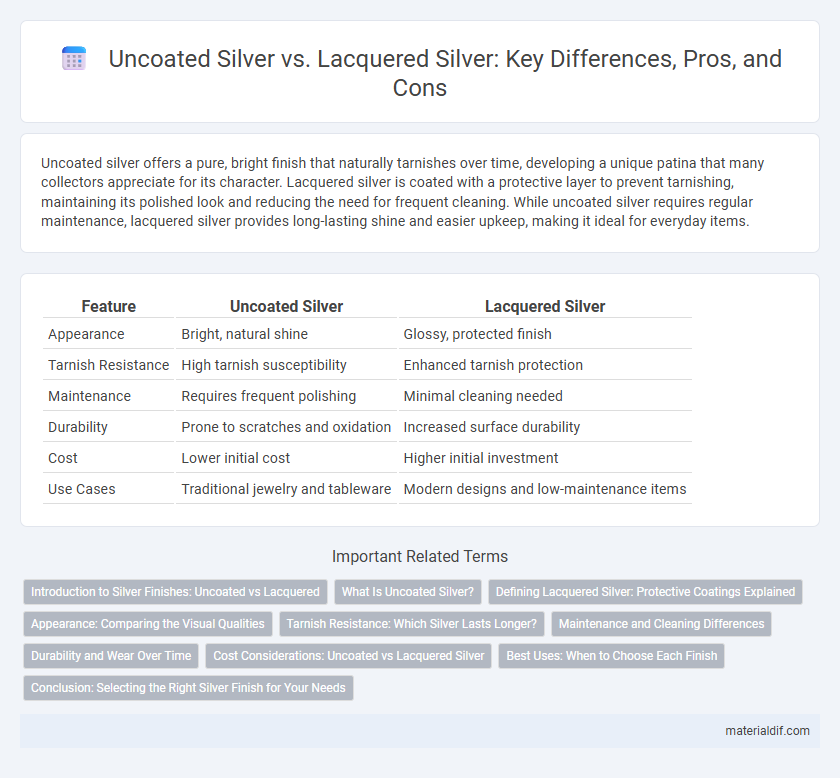Uncoated silver offers a pure, bright finish that naturally tarnishes over time, developing a unique patina that many collectors appreciate for its character. Lacquered silver is coated with a protective layer to prevent tarnishing, maintaining its polished look and reducing the need for frequent cleaning. While uncoated silver requires regular maintenance, lacquered silver provides long-lasting shine and easier upkeep, making it ideal for everyday items.
Table of Comparison
| Feature | Uncoated Silver | Lacquered Silver |
|---|---|---|
| Appearance | Bright, natural shine | Glossy, protected finish |
| Tarnish Resistance | High tarnish susceptibility | Enhanced tarnish protection |
| Maintenance | Requires frequent polishing | Minimal cleaning needed |
| Durability | Prone to scratches and oxidation | Increased surface durability |
| Cost | Lower initial cost | Higher initial investment |
| Use Cases | Traditional jewelry and tableware | Modern designs and low-maintenance items |
Introduction to Silver Finishes: Uncoated vs Lacquered
Uncoated silver features a natural, bright luster that develops a patina over time, offering authenticity and ease of repair but requiring regular polishing to prevent tarnish. Lacquered silver is coated with a clear protective layer that inhibits oxidation and maintains its shine with minimal maintenance, making it ideal for everyday use and preserving intricate designs. Choosing between uncoated and lacquered finishes depends on the balance between desired appearance, maintenance preferences, and longevity of the silver piece.
What Is Uncoated Silver?
Uncoated silver refers to pure silver items that lack any protective coating, leaving the metal exposed to air and moisture, which can cause tarnishing over time. This type of silver is favored for its natural luster and authentic patina that develops with use and age, offering a timeless aesthetic appeal. Without a clear lacquer, uncoated silver requires regular polishing to maintain its shine and prevent oxidation from environmental elements.
Defining Lacquered Silver: Protective Coatings Explained
Lacquered silver is silver that has been coated with a protective layer of clear lacquer to prevent tarnishing and reduce the need for frequent polishing. This coating acts as a barrier against environmental factors such as moisture and air pollutants, which cause silver oxidation. In contrast, uncoated silver requires regular maintenance to preserve its shine and prevent darkening caused by sulfur compounds in the atmosphere.
Appearance: Comparing the Visual Qualities
Uncoated silver exhibits a bright, reflective surface with a natural metallic luster that enhances its classic appeal, but it is prone to tarnishing and requires regular polishing. Lacquered silver maintains a consistent, glossy finish that resists oxidation and discoloration, preserving its appearance over time with minimal maintenance. The clear lacquer layer creates a slightly warmer tone and smooth texture, reducing the intensity of silver's natural shine while offering long-lasting protection.
Tarnish Resistance: Which Silver Lasts Longer?
Uncoated silver tends to tarnish more quickly due to its direct exposure to air and moisture, which causes oxidation and darkening over time. Lacquered silver, coated with a protective layer, significantly resists tarnish by creating a barrier against environmental elements, thereby preserving its shine and appearance longer. Despite occasional re-coating requirements, lacquered silver generally offers superior long-term tarnish resistance compared to uncoated silver.
Maintenance and Cleaning Differences
Uncoated silver requires regular polishing with a silver-specific cleaner to prevent tarnish caused by exposure to air and moisture, while lacquered silver offers a protective layer that reduces the need for frequent cleaning. When maintaining lacquered silver, gentle wiping with a soft cloth is sufficient to remove fingerprints and dust without damaging the protective coating. Avoid abrasive cleaners on lacquered silver to preserve its finish, whereas uncoated silver benefits from more intensive cleaning to restore its natural shine.
Durability and Wear Over Time
Uncoated silver offers a classic shine but is highly prone to tarnishing and requires frequent polishing to maintain its luster over time. Lacquered silver features a protective coating that significantly enhances durability by preventing oxidation and minimizing surface wear. While lacquer can lose its effectiveness or chip with extended use, it provides superior long-term resistance against discoloration compared to uncoated silver.
Cost Considerations: Uncoated vs Lacquered Silver
Uncoated silver typically incurs lower initial costs due to the absence of protective coatings, but it demands more frequent maintenance to prevent tarnishing, which can increase long-term expenses. Lacquered silver involves higher upfront investment as the protective layer minimizes oxidation and reduces the need for constant polishing, thereby lowering maintenance costs over time. Choosing between uncoated and lacquered silver depends on balancing immediate budget constraints against durability and upkeep requirements.
Best Uses: When to Choose Each Finish
Uncoated silver is ideal for jewelry or items requiring frequent polishing and a natural aging process, as it develops a unique patina over time. Lacquered silver suits office accessories, picture frames, or decorative pieces that benefit from long-lasting shine without oxidation or tarnishing. Choosing uncoated silver enhances character with age, while lacquered silver offers low-maintenance durability and consistent brightness.
Conclusion: Selecting the Right Silver Finish for Your Needs
Uncoated silver offers a classic, natural shine but requires regular polishing to prevent tarnish, making it ideal for those who appreciate traditional maintenance. Lacquered silver provides long-lasting protection against oxidation and scratches, suitable for users seeking low-maintenance durability and consistent appearance. Choosing between uncoated and lacquered silver depends on your preference for upkeep frequency and desired silver longevity.
Uncoated Silver vs Lacquered Silver Infographic

 materialdif.com
materialdif.com